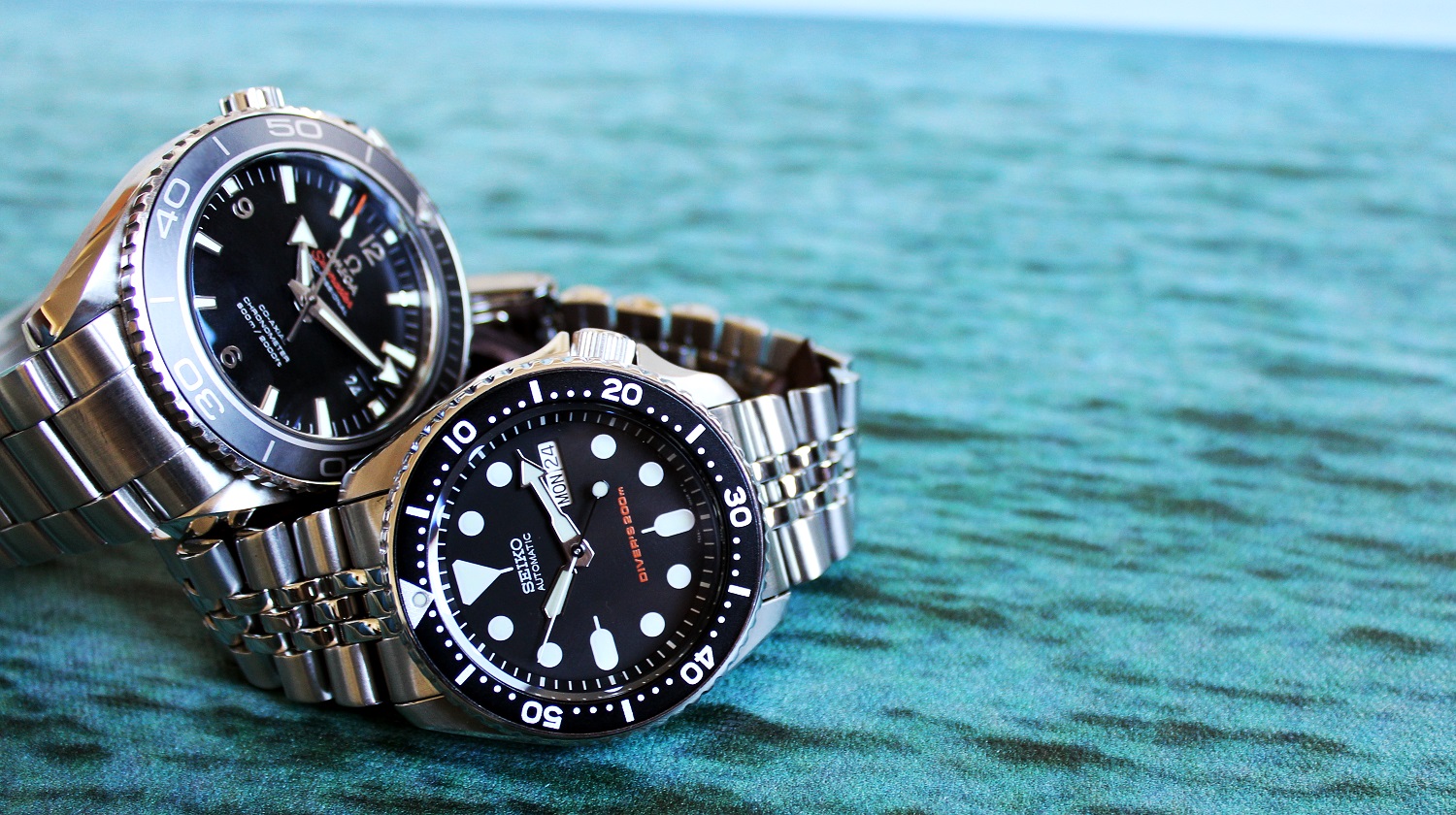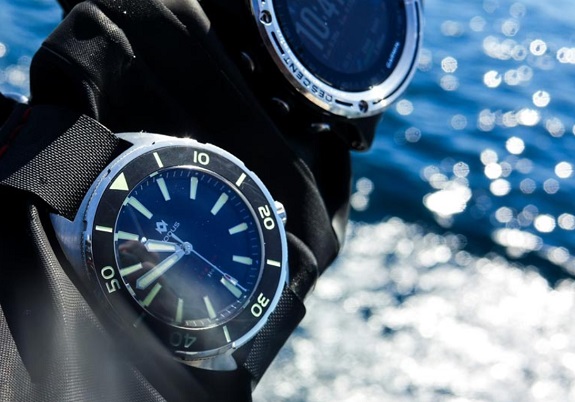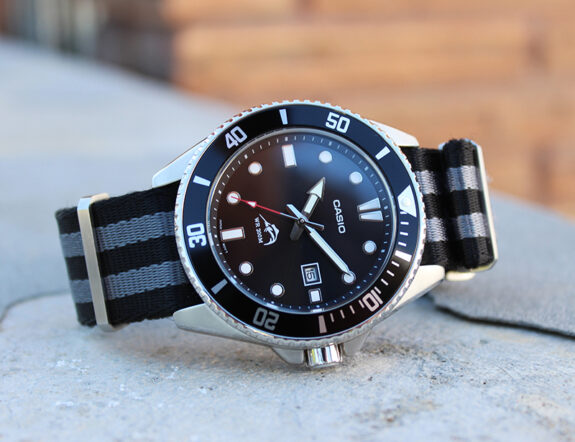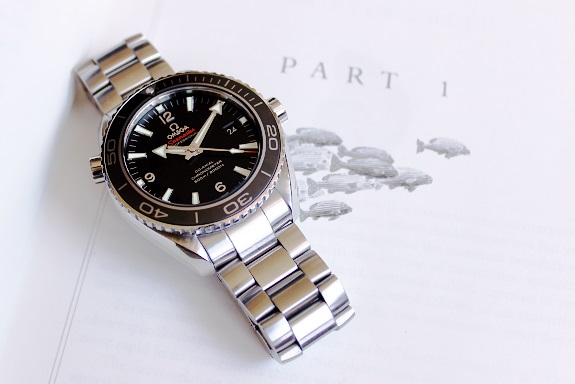I’ve been thinking a lot about water resistance in Dive Watches. Specifically: what’s the point? 50 meters of water resistance makes sense to me. But the recreational limit for scuba diving is 40 meters. So 200m water resistance is kind of… pointless? To go down that deep, it would be a six hour technical dive on rebreathers and crazy gas mixes and super fancy equipment, and I doubt anyone would want to wear an expensive watch in that context. I guess this idea of “what’s the point” could be applied to just about anything in the watch world (Quartz vs. mechanical, etc) and the answer is all about the art of watch craftsmanship or somesuch, but for some reason, seeing a fancy watch company advertising a 200m water resistant watch on the back of one of my scuba magazines just bugged me. – Michael R.
Wait, so you’re saying you DON’T live in a pineapple under the sea?
As someone who has never even snorkeled, once ruptured his planter fascia jumping off a pontoon boat (yes really) and up until recently (like yesterday) thoroughly believed one of the major myths about watch water resistance (we’ll get to that) I am wholly unqualified to explain this.
BUT THAT DOESN’T MEAN I’M NOT GONNA TRY!
The Seiko Samurai: Omega Planet Ocean looks for a lot less money.
The Seemingly Contradictory Reality
Watch water resistance is really confusing. Along with all of the technical jargon and two separate sets of testing rules and methods (hot plates! carefully placed droplets of water! pressurized testing containers!) there also appears to be a ton of mostly de-bunked myths floating about. Here are two conflicting realities surrounding watch water resistance:
- Wristwatch manufacturers will specifically tell you DON’T swim with a watch that has 30m water resistance or less.
- You have people who ACTUALLY SCUBA DIVE using 50m Timex Ironman athletic watches as backups to their dive computers, and many divers will tell you that 200m or 300m is wayyyyy overkill.
30m but can’t swim with it? 50m is good for SCUBA diving and 200m is overkill? The hell is going on here? Which do you want me to believe?
The Orient Ray. Automatic. Inexpensive. Plenty water resistant. Reviewed here.
The Myth that Sounds Way Too Good.
One of the more believable myths about watch water resistance (the one I used to believe wholeheartedly) says that these two seemingly contradictory realities can actually co-exist because watches are usually tested statically. Meaning: They aren’t moving. They’re cooked up in a pressurized casserole dish or whatever, but the watch is just sitting there. And if you’re an average landlubber knucklehead who goes for the occasional dip, you’ll need that extra protection because swimming/smashing your hands into the water will greatly increase the stress put on the watch (Force = Mass x Acceleration). Doing a cannonball off the pier or swimming your way through waves really does a number on the crown, case, and gaskets, amiright?
The problem is, it’s just not true. It SOUNDS great, but, the truth is you can thrash all you want. You’re not gonna hurt your watch with your feeble human forces.
The Nodus Avalon. A tremendously cool looking backup to the digital dive computer.
So if that myth (and all the others) aren’t true, why do watch manufacturers insist that a watch with 30m of water resistance isn’t good enough to play a quick game of Marco Polo with? It’s because, and this is speculation: They don’t trust their work. And perhaps most importantly, they don’t trust their customers. You and me included. Here’s what I mean:
It’s the crown, Stupid.
I’m stupid. You might be stupid too. The moron who was working the stump grinder for our tree removal job the other day and shredded right through a plainly visible sprinkler head and didn’t even realize it? Utter and complete broth-brain. Sometimes our gray matter just goes off the boil.
And if you’re stupid and forget to push the crown back in on your watch, then the water resistance is almost certainly zero. It’s not sealed. You have a leak. There is, in fact, a hole in your bucket dear Liza. More than a few times in my life I’ve had a watch on my wrist for an extended period of time and then, out of nowhere, I have noticed that the crown wasn’t “in.” How does this happen? I don’t know! I’m stupid! But if that’s the case when you hit the water, the water rushes in, and, blammo. Your watch is a paperweight. Also, pulling that crown out and pushing it in hundreds of times over the life of a cheap watch will almost certainly wear down those pieces parts, and make it more susceptible to failure/not securing correctly when you have pushed it in. And thus, watchmakers say: “Yeah, don’t swim with the 30m stuff. Safer for everyone.”
Christopher Ward’s C60 Trident Pro 300 w/ a 300m water resistance rating.
You better believe that crown screws down.
Why I Still (foolishly) Rationalize 200m for Swimming
I personally don’t wear anything in the water with a resistance of less than 200m, because that makes me the most comfortable and those are usually the watches with screw down crowns. No screw down crown = a (small) risk of forgetting to seal the watch by securing the crown. It is one extra step to prevent me from being stupid. If I’m winding a watch or setting the time or date, I need to screw the crown in to be “done” with that process. That’s how I view it. THAT SAID I’ve done plenty of swimming and dancing in the rain with 100m rated watches and I haven’t had any trouble at all. Yet.
More Questions. More Rationalizing.
So why have an over-engineered dive watch that’s 100m, 200m or 300m water resistant? Let’s explore that. Why have a car that can go 160 mph? Why have a pair of fancy heritage work boots when you sit at a desk all day? Why would you want a vacuum cleaner strong enough to pick up a bowling ball? Or an amplifier that goes to 11? Because a lot of it is marketing. Or status. Or both. But, and perhaps this is a stretch, many products that are over engineered for tasks you’ll never perform seem to also feel, work, and let’s be honest, look better in day to day operation compared to the cheaper, less capable competition.
The $50, 200m quartz diver: Casio MDV106-1AV
(Strap is an aftermarket surpeme nato from Crown and Buckle)
TL;DR: Water resistance marks are confusing, mostly antiquated standards which have been weaponized by brands for marketing. They also can (but not always) indicate overall fit, finish, and perhaps durability of a watch due to the phenomenon of over-engineered consumer products possessing associative, more easy to notice, quality and style advantages over cheaper competitors. Also, I concede that the above post is nowhere near thorough enough for any watch snobs reading this. I pray to Poseidon for your forgiveness.
STILL TL;DR: A Toyota Camry can go 130 mph. It is a fine automobile. James Bond drives an Aston Martin. ¯\_(ツ)_/¯






